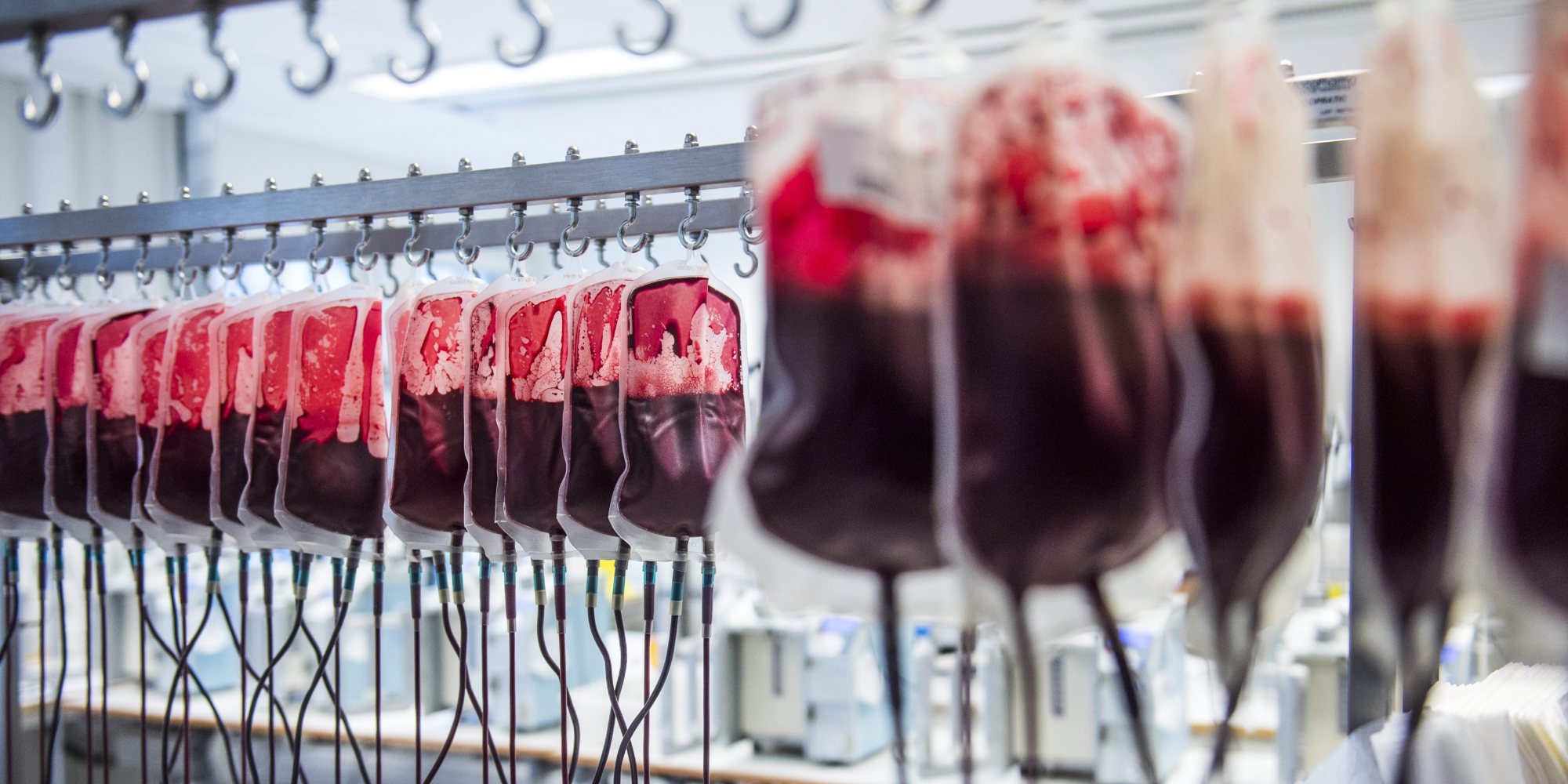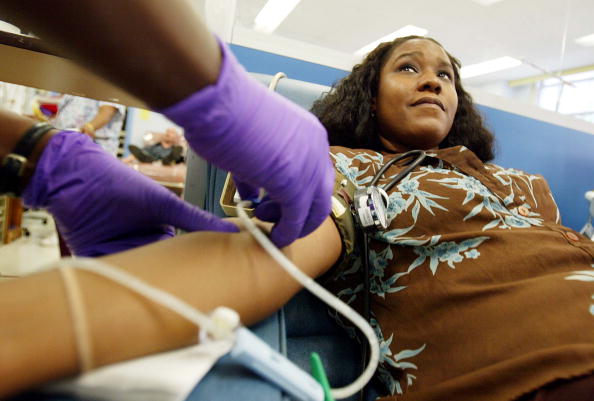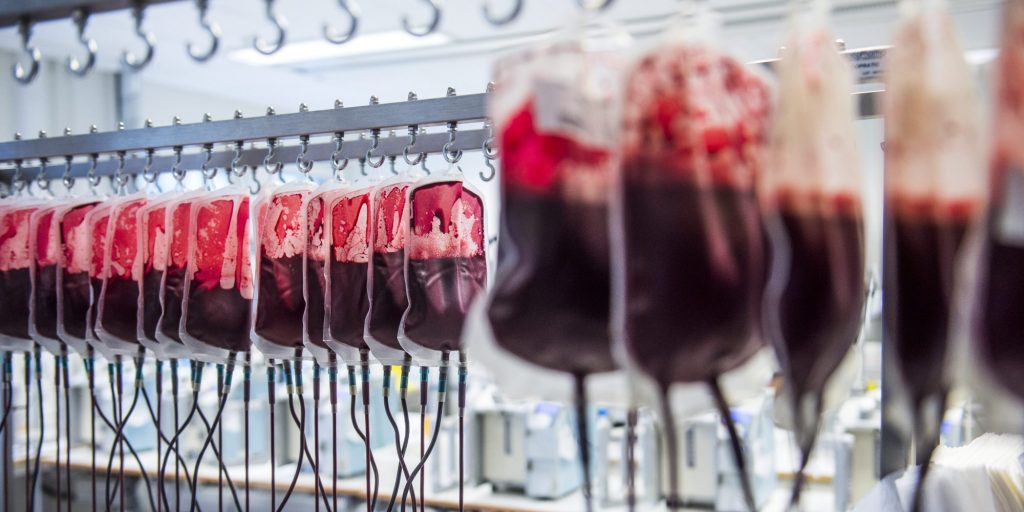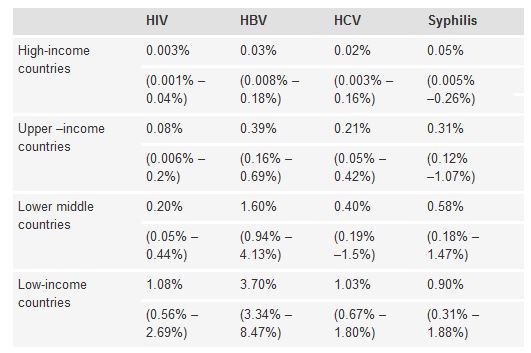
Key facts*
- Of the 112.5 million blood donations collected globally, approximately half of these are collected in high-income countries, home to 19% of the world’s population.
- In low-income countries, up to 65% of blood transfusions are given to children under 5 years of age; whereas in high-income countries, the most frequently transfused patient group is over 65 years of age, accounting for up to 76% of all transfusions.
- Based on samples of 1000 people, the blood donation rate is 32.1 donations in high-income countries, 14.9 donations in upper-middle-income countries, 7.8 donations in lower-middle-income countries and 4.6 donations in low-income countries.
- An increase of 10.7 million blood donations from voluntary unpaid donors has been reported from 2008 to 2013. In total, 74 countries collect over 90% of their blood supply from voluntary unpaid blood donors; however, 71 countries collect more than 50% of their blood supply from family/replacement or paid donors.
- Only 51 of 180 reporting countries produce plasma-derived medicinal products (PDMP) through the fractionation of plasma collected in the reporting country. A total of 96 countries reported that all PDMP are imported, 17 countries reported that no PDMP were used during the reporting period, and 16 countries did not respond to the question.
National blood policy and organization
Blood transfusion saves lives and improves health, but many patients requiring transfusion do not have timely access to safe blood. Providing safe and adequate blood should be an integral part of every country’s national health care policy and infrastructure.
WHO recommends that all activities related to blood collection, testing, processing, storage and distribution be coordinated at the national level through effective organization and integrated blood supply networks. The national blood system should be governed by national blood policy and legislative framework to promote uniform implementation of standards and consistency in the quality and safety of blood and blood products.
In 2013, 68% of reporting countries, or 122 out of 179, had a national blood policy. Overall, 58% of reporting countries, or 105 out of 181, have specific legislation covering the safety and quality of blood transfusion, including:
- 79% of high-income countries
- 64% of middle-income countries
- 41 % of low-income countries.
Blood supply
About 112.5 million blood donations are collected worldwide. More than half of these are collected in high-income countries, home to 19% of the world’s population.
About 13 000 blood centres in 176 countries report collecting a total of 110 million donations. Collections at blood centres vary according to income group. The median annual donations per blood centre is 5400 in the low- and middle-income countries, as compared to 16 000 in the high-income countries.
There is a marked difference in the level of access to blood between low- and high-income countries. The whole blood donation rate is an indicator for the general availability of blood in a country. The median blood donation rate in high-income countries is 32.1 donations per 1000 people. This compares with 14.9 donations per 1000 people in upper-middle-income countries, 7.8 donations per 1000 people in lower-middle-income countries, and 4.6 donations per 1000 people in low-income countries.
67 countries report collecting fewer than 10 donations per 1000 people. Of these, 38 countries are in the WHO African Region, 5 in the WHO Region of the Americas, 6 in the WHO Eastern Mediterranean region, 5 in the WHO European Region, 6 in the WHO South-Eastern Asia Region, and 8 in the WHO Western Pacific Region. All are low- or middle-income countries.
Blood donors
Age and gender of blood donors

Data about the gender profile of blood donors show that globally 30% of blood donations are given by women, although this ranges widely. In 18 of the 118 reporting countries, less than 10% of donations are given by female donors.
The age profile of blood donors shows that, proportionally, more young people donate blood in low- and middle-income countries than in high-income countries. Demographic information of blood donors is important for formulating and monitoring recruitment strategies.
Types of blood donors
There are 3 types of blood donors:
- voluntary unpaid
- family/replacement
- paid.
An adequate and reliable supply of safe blood can be assured by a stable base of regular, voluntary, unpaid blood donors. These donors are also the safest group of donors as the prevalence of bloodborne infections is lowest among this group. World Health Assembly resolution WHA63.12 urges all Member States to develop national blood systems based on voluntary unpaid donations and to work towards the goal of self-sufficiency.
Data reported to WHO shows significant increases of voluntary unpaid blood donations in low- and middle-income countries:
- An increase of 10.7 million blood donations from voluntary unpaid donors from 2008 to 2013 has been reported by 159 countries. The highest increase of voluntary unpaid blood donations is in the South-East Asian (75%) Region and African Region (37%). The maximum increase in absolute numbers was reported in the South-East Asia region (5.3 million donations), followed by the Western Pacific Region (2.8 million donations).
- 74 countries collect more than 90% of their blood supply from voluntary unpaid blood donations (39 high-income countries, 26 middle-income countries and 9 low-income countries). This includes 57 countries with 100% (or more than 99%) of their blood supply from voluntary unpaid blood donors.
- In 71 countries, more than 50% of the blood supply is still dependent on family/replacement and paid blood donors (11 high-income countries, 45 middle-income countries and 16 low-income countries).
- 24 countries still report collecting paid donations in 2013, around 1 650 000 donations in total.
Blood screening
WHO recommends that all blood donations should be screened for infections prior to use. Screening for HIV, hepatitis B, hepatitis C, and syphilis should be mandatory. Blood screening should be performed according to the quality system requirements. Of reporting countries, 13 are not able to screen all donated blood for 1 or more of the above infections.
Irregular supply of test kits is one of the most commonly reported barriers to screening. 99.6% of the donations in high-income countries are screened following basic quality procedures, as compared to 97% in upper-middle-income countries, 81% in lower-middle-income countries and 66 % in low-income countries. The prevalence of transfusion-transmissible infections in blood donations in high-income countries is considerably lower than in low- and middle-income countries (Table 1).
Table 1. Prevalence of transfusion-transmissible infections in blood donations (Median, Interquartile range (IQR)), by income groups
These differences reflects the variation in prevalence among population who are eligible to donate blood, the type of donors (such as voluntary unpaid blood donors from lower risk populations) and the effectiveness of the system of educating and selecting donors.
Blood processing
Blood collected in an anticoagulant can be stored and transfused to a patient in an unmodified state. This is known as ‘whole blood’ transfusion. However, blood can be used more effectively if it is processed into components, such as red cell concentrates, platelet concentrates, plasma and cryoprecipitate. In this way, it can meet the needs of more than one patient.
The capacity to provide patients with the different blood components they require is still limited in low-income countries: 50% of the blood collected in low-income countries is separated into components, 59% in lower-middle-income countries, 92% in upper-middle-income countries, and 97% in high-income countries.
Supply of plasma-derived medicinal products (PDMP)
World Health Assembly resolution WHA63.12 urges Member States to establish, implement and support nationally-coordinated, efficiently-managed and sustainable blood and plasma programmes according to the availability of resources, with the aim of achieving self-sufficiency. It is the responsibility of individual governments to ensure sufficient and equitable supply of plasma-derived medicinal products, namely immunoglobulins and coagulation factors, which are needed to prevent and treat a variety of serious conditions that occur worldwide.
Only 51 of 180 reporting countries produce plasma-derived medicinal products (PDMP) through the fractionation of plasma collected in the reporting country. A total of 96 countries reported that all PDMP are imported, 17 countries reported that no PDMP were used during the reporting period, and 16 countries did not respond to the question.
Around 14.4 million litres of plasma from 44 reporting countries was fractionated for the production of PDMP during the year. This includes around 41% of plasma recovered from the whole blood donations.
Clinical use of blood
Unnecessary transfusions and unsafe transfusion practices expose patients to the risk of serious adverse transfusion reactions and transfusion-transmissible infections. Unnecessary transfusions also reduce the availability of blood products for patients who are in need.
WHO recommends the development of systems, such as hospitals transfusion committees and haemovigilance, to monitor and improve the safety of transfusion processes. In this regard:
- 126 countries have national guidelines on the appropriate clinical use of blood: 34 countries in the African region (74% of reporting countries in the region), 20 in the Americas (57 %), 14 in the Eastern Mediterranean (70%), 33 in Europe (77%), 8 in the South East Asia (72%), and 17 in the Western Pacific (68%).
- Transfusion committees are present in 39% of the hospitals performing transfusions: 14% of hospitals performing transfusion in the African region have a transfusion committee, 20% in the Americas, 57% in the Eastern Mediterranean, 92% in Europe, 57% in South-East Asia and 25% in the Western Pacific.
- Clinical audits are conducted in 54% of hospitals performing transfusion in high-income countries and in 42% of hospitals in the middle- and low-income countries.
- Systems for reporting adverse transfusion events are present in 17 % of hospitals in the African region, 91% in the Americas, 32% in the Eastern Mediterranean, 99% in Europe, 59% in South East Asia and 37% in the Western Pacific.
- 39% of reporting countries have a haemovigilance system. The European region has the highest percentage of countries with haemovigilance systems (77%), followed by South-East Asia (46%), the Eastern Mediterranean (35%), the Western Pacific (32%), Africa (26%), and the Americas (14%).
Blood transfusions
There are great variations between countries in terms of the age distribution of transfused patients. For example, in the high-income countries, the most frequently transfused patient group is over 65 years of age, which accounts for up to 76% of all transfusions. In the low-income countries, up to 65% of transfusions are for children under the age of 5 years.
In high-income countries, transfusion is most commonly used for supportive care in cardiovascular surgery, transplant surgery, massive trauma, and therapy for solid and haematological malignancies. In low- and middle-income countries it is used more often to manage pregnancy-related complications and severe childhood anaemia.
WHO response
The risk of transmission of serious infections, including HIV and hepatitis, through unsafe blood and chronic blood shortages brought global attention to the importance of blood safety and availability. With the goal of ensuring universal access to safe blood and blood products, WHO has been at the forefront to improve blood safety and availability, and recommends the following integrated strategy for blood safety and availability:
- Establishment of a national blood system with well-organized and coordinated blood transfusion services, effective evidence-based and ethical national blood policies, and legislation and regulation, that can provide sufficient and timely supplies of safe blood and blood products to meet the transfusion needs of all patients.
- Collection of blood, plasma and other blood components from low-risk, regular, voluntary unpaid donors through the strengthening of donation systems, and effective donor management, including care and counselling.
- Quality-assured screening of all donated blood for transfusion-transmissible infections, including HIV, hepatitis B, hepatitis C and syphilis, confirmatory testing of the results of all donors screen-reactive for infection markers, blood grouping and compatibility testing, and systems for processing blood into blood products (blood components for transfusion and plasma derived-medicinal products), as appropriate, to meet health care needs.
- Rational use of blood and blood products to reduce unnecessary transfusions and minimize the risks associated with transfusion, the use of alternatives to transfusion where possible, and safe and good clinical transfusion practices, including patient blood management.
- Step-wise implementation of effective quality systems, including quality management, standards, good manufacturing practices, documentation, training of all staff, and quality assessment.
Through its Blood and Transfusion Safety programme, WHO supports countries in developing national blood systems to ensure timely access to safe and sufficient supplies of blood and blood products and good transfusion practices to meet the patients’ needs. The programme provides policy guidance and technical assistance to countries for ensuring universal access to safe blood and blood products and work towards self-sufficiency in safe blood and blood products based on voluntary unpaid blood donation to achieve universal health coverage.
*Data source: This fact sheet is based on the data obtained through the WHO Global Database on Blood Safety (GDBS) for the year 2013 which were reported by 156 countries. To give a more complete overview of the global situation, data for the year 2012 have been used from 15 countries and data for the year 2011 have been used from 9 countries, where current data are not available. Overall, responses received from 180 countries cover 98.3% of the world’s population.


